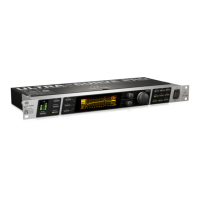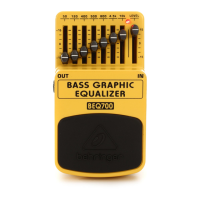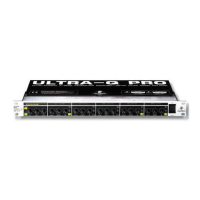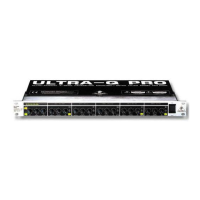
Do you have a question about the Behringer Ultracurve Pro DEQ2496 and is the answer not in the manual?
| Audio input | - |
|---|---|
| Product color | Black |
| Equalizer bands quantity | 61 |
| Depth | 482.6 mm |
|---|---|
| Width | 215 mm |
| Height | 44.5 mm |
| Weight | 2240 g |
Essential safety guidelines and warnings for operating the device, including electrical shock and fire prevention.
Legal terms and conditions regarding product accuracy, liability, and intellectual property.
Information on warranty terms and conditions, including how to register for extended coverage.
Guidance on initial setup, shipment inspection, warranty card completion, and operational considerations.
Explanation of the manual's structure and how to use it for reference, including website resources.
Detailed description of the buttons, LED meters, LC display, and rotary controls on the front panel.
Description of input/output connectors, MIDI, and wordclock connections on the rear panel.
How to navigate menus, switch pages, and edit parameters using the device's controls.
Overview of different equalizer types and their associated menu structures.
Detailed settings and operation for the Graphic Equalizer (GEQ) module.
Detailed settings for parametric equalization, including band adjustments, bandwidth, and gain.
Configuration for dynamic equalization effects based on signal level, including threshold and ratio.
Further parameters for Dynamic EQ, including attack, release, and threshold adjustments.
Functionality and settings for identifying and eliminating audio feedback frequencies.
Advanced settings for FBD, including SNGL/AUTO modes and LEARN mode for feedback suppression.
Stereo imager function for processing stereo signals and adjusting width, asymmetry, and rotation.
Controls for asymmetry, rotation, bass trim, and shuffle effects in the WIDTH menu.
Settings for compressor, expander, and peak limiter functions, including knee and hold parameters.
Configuration of general setup, display contrast, channel mode, and MIDI settings.
Configuration for MIDI channel, control change, program change, and system exclusive data.
Setting input/output sources, digital formats, sample rates, and delay functions.
Options for bypassing individual modules or the entire signal path for comparison.
Using the FFT analyzer, noise correction, and display settings for audio analysis.
Further RTA settings like rate, peak hold, noise gain, and large format display.
Automatic frequency response correction using the RTA and measurement microphone.
Saving, recalling, and protecting presets and individual modules.
Loading and storing individual modules within presets, handling dual mono exceptions.
Viewing input/output levels with VU/peak meters and connecting measurement microphones.
Using the DEQ2496 as a primary equalizer for live sound reinforcement, with tips for setup.
Applying the DEQ2496 for monitor mix equalization and feedback suppression.
Utilizing the DEQ2496 for mastering, A/D-D/A conversion, and general sound shaping.
Employing the DEQ2496's delay function for run-time correction in speaker systems.
Setting up MIDI communication for control and data transfer using DIN jacks.
Connecting audio signals using balanced XLR and unbalanced TS connectors.
Using digital audio interfaces for signal transmission over XLR or optical connectors.
Synchronizing the DEQ2496 with external digital equipment using a BNC wordclock signal.
Information on software updates, user feedback, and where to find new revisions.
Details on digital input and output formats, impedance, and nominal levels.
Technical data for Graphic EQ, Parametric EQ, Dynamic EQ, and Feedback Destroyer filters.
Specifications for delay functions, level meters, SPL meter, and noise generator.
Technical details for the limiter function, the digital 61-band FFT analyzer, and detectors.
Information on the LC display type, backlighting, contrast, and memory preset capacity.
Comprehensive chart detailing MIDI send/receive capabilities for various functions like CC and Program Change.
Statement regarding the device's compliance with FCC rules for Class B digital devices and harmful interference.










